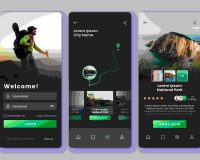Enhancing User Engagement in Websites for Qatar: UX Design Qatar
In the bustling digital landscape of Qatar, where websites serve as the gateway to businesses’ online presence, user engagement holds the key to success. As the competition intensifies, businesses are increasingly turning to UX Design Qatar and User Experience (UX) design principles to create websites that captivate and retain their audience. In this blog, we’ll explore the fundamental UX design principles that can elevate user engagement on websites tailored for Qatar’s diverse audience.
Understanding Qatar's Audience:
Before delving into UX design principles, it’s essential to understand the unique characteristics of Qatar’s audience. With a diverse population comprising locals, expatriates, and tourists, websites must cater to a broad range of cultural backgrounds, languages, and preferences. By conducting thorough research and gaining insights into the target audience, businesses can tailor their website’s UX design to resonate with Qatar’s diverse demographic. Implementing UX Design Qatar strategies ensures that websites are not only user-friendly but also culturally relevant and engaging for the audience in Qatar.
1. Clear Navigation:
Clear and intuitive navigation is the cornerstone of a user-friendly website. Visitors to a website in Qatar should be able to find what they’re looking for quickly and easily. Implementing a well-organized menu structure, utilizing breadcrumbs, and providing prominent calls-to-action can guide users seamlessly through the website, enhancing their overall experience and encouraging deeper engagement.
2. Responsive Design:
With mobile usage on the rise in Qatar, ensuring that websites are optimized for various devices and screen sizes is paramount. Responsive design, especially tailored for UX Design Qatar, ensures that the website adapts fluidly to different platforms, providing a consistent and visually appealing experience across desktops, smartphones, and tablets. By prioritizing responsiveness, businesses can cater to the mobile-centric preferences of Qatar’s tech-savvy population while adhering to UX Design Qatar standards.
3. Performance Optimization:
In a fast-paced digital environment, users in Qatar expect websites to load quickly and perform smoothly. Optimizing website performance through techniques such as image optimization, minification of code, and leveraging content delivery networks (CDNs) can significantly enhance user experience. By minimizing loading times and reducing friction, businesses can keep visitors engaged and prevent them from bouncing off the site.
4. Localization:
To truly connect with Qatar’s audience, websites must be localized to cater to cultural preferences and language requirements. Providing content in both English and Arabic, incorporating culturally relevant imagery and references, and adhering to Islamic principles where applicable can foster a sense of familiarity and resonance among users. By embracing localization, businesses can strengthen their connection with the local community and enhance user engagement. Incorporating UX Design Qatar principles into the localization process ensures that websites are not only culturally sensitive but also optimized for maximum user engagement and satisfaction.
5. Compelling Visual Design:
Visual elements play a crucial role in capturing users’ attention and conveying brand identity, especially in UX Design Qatar. Employing a visually appealing design that aligns with Qatar’s aesthetic preferences can leave a lasting impression on visitors. From choosing harmonious color schemes to incorporating high-quality imagery and typography, every aspect of visual design should contribute to creating an immersive and engaging user experience tailored to the unique tastes and cultural context of Qatar.





